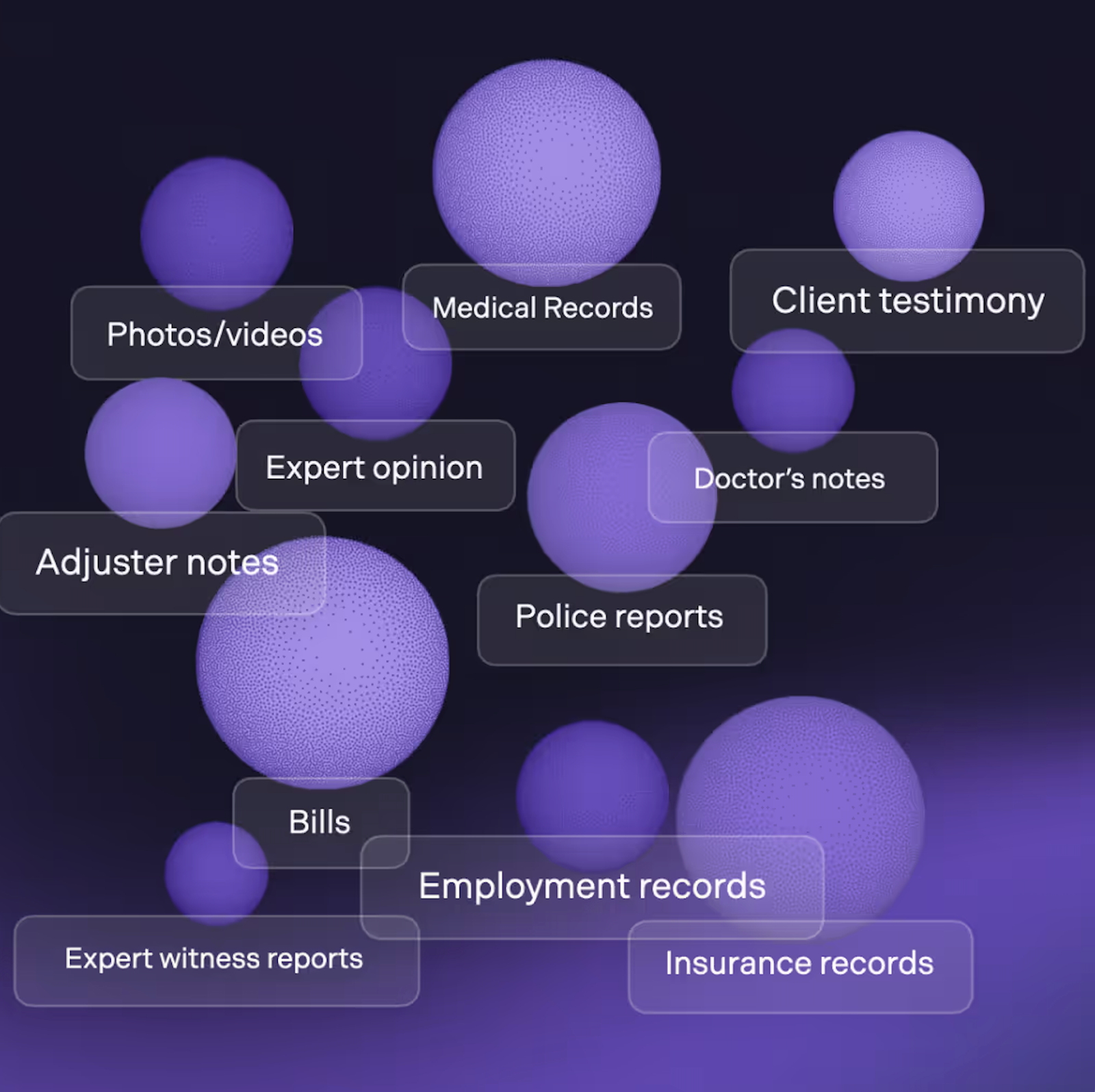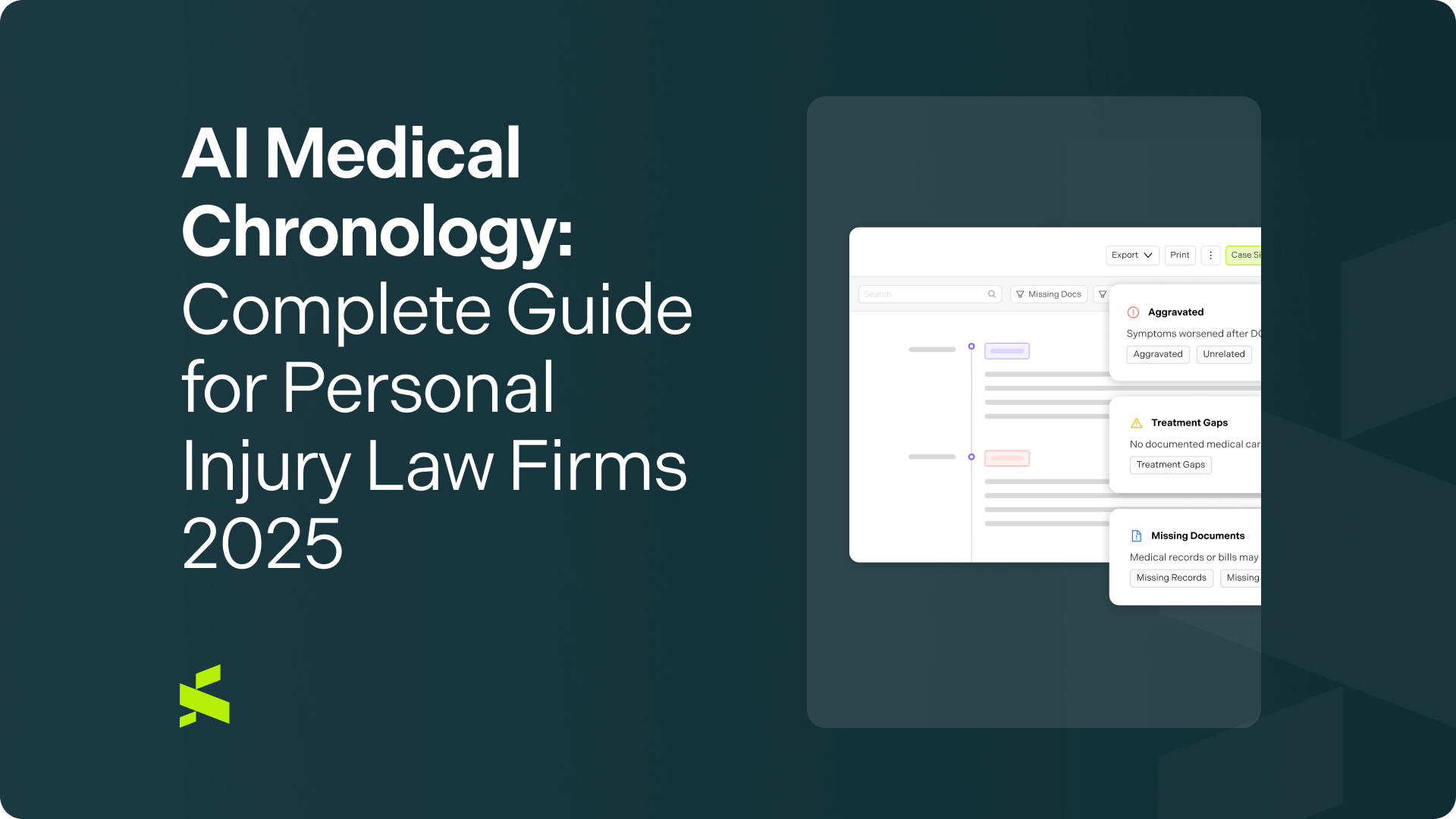Your paralegal just received 3,000 pages of medical records for a birth injury case. With traditional medical records review, they'd spend two weeks manually building a timeline in Excel. By then, you're already behind on settlement negotiations.
AI medical chronologies change this. What took weeks now happens in hours, and the transformation goes far beyond speed.
This guide covers everything personal injury attorneys and legal teams need to know about AI medical chronologies: how they work, where they excel, their limitations, and how to evaluate vendors.
Contents:
- What AI actually changes in the chronology-building process (beyond just speed)
- The six criteria that define a good AI medical chronology
- Honest assessment of AI limitations and how leading firms address them
- How to evaluate AI chronology software for accuracy and compliance
- Workflows that combine AI speed with human verification
- How chronologies become the foundation for demands, discovery, and trial prep
Whether you're currently building chronologies manually, outsourcing to vendors, or evaluating AI solutions, this guide will help you understand how AI fits into personal injury practice, and how to use it strategically.
What is an AI medical chronology?
An AI medical chronology is a timeline of medical events automatically extracted and organized from medical records using artificial intelligence. Unlike traditional chronologies built manually by paralegals or outsourced reviewers, AI chronologies are generated through natural language processing models trained to understand medical documentation.
But here's what most definitions miss: AI medical chronologies aren't just faster versions of the old static document. They represent a fundamental shift in how legal teams interact with medical evidence.
Traditional vs. AI medical chronologies
Traditional medical chronologies are static documents, typically Word files or Excel spreadsheets. A paralegal reads through records, manually enters key events into a timeline, and exports a finished document. If you need to find when a specific symptom appeared, you're using Ctrl+F or scrolling through pages. If new records arrive, someone manually integrates them and re-exports.
AI medical chronologies are interactive intelligence layers built on top of your medical records. Instead of a static document, you have a searchable, filterable database of medical events that you can query in natural language. "When did physical therapy start?" "Show me all visits where back pain was mentioned." "What treatments happened between the accident and the first MRI?" The system answers instantly with citations back to source documents.
The three layers of AI medical chronologies
Modern AI chronology systems work in three distinct layers:
1. Extraction layer
The AI reads through medical records (physician notes, lab reports, imaging studies, discharge summaries) and identifies discrete medical events. It recognizes dates, diagnoses (including ICD codes), treatments, medications, providers, and clinical findings. This happens across thousands of pages in minutes.

2. Organization layer
Events are deduplicated, normalized, and arranged chronologically. The system collapses duplicate lab results, standardizes terminology (linking "MI" and "myocardial infarction" as the same event), and flags gaps in treatment or missing records.
3. Intelligence layer
This is where AI chronologies diverge from traditional ones. The system enables natural language queries, pattern recognition across events, and integration with other case tools. You can ask questions, filter views, and surface insights that would require hours of manual analysis.
Why this matters for PI practice
A static chronology forces you to know what you're looking for before you find it. An interactive AI chronology lets you explore the medical story from multiple angles during settlement negotiations, depositions, and trial prep. The chronology stops being a deliverable and becomes your case's medical intelligence system.
How AI changes medical records review
Most firms approach AI medical chronologies with one question: "How much time will this save?" It's the wrong question (or at least incomplete). Time savings matter, but they're a byproduct of fundamental workflow changes that AI enables.
To understand what actually changes, let's walk through the traditional process first.
{{cta-1="/blog-components/ai-medical-chronology-the-complete-guide-for-personal-injury-law-firms-2025"}}
The traditional medical records review workflow
{{medical-records-workflow="/blog-components/ai-medical-chronology-the-complete-guide-for-personal-injury-law-firms-2025"}}
Total time investment: 40-80 hours for moderately complex cases
What AI changes
AI restructures this process entirely. Here's how:
1. Parallel processing replaces sequential reading
Human review is inherently sequential. You read page 1, then page 2, then page 3. AI processes all pages simultaneously. It's scanning the entire record set for patterns, events, and relationships while you're still organizing the files.
More importantly, AI doesn't suffer from attention degradation. When a paralegal is on page 1,847 of medical records, they're more likely to miss details. AI maintains the same level of scrutiny on page 1 as on page 5,000.
2. Extraction becomes automatic (but requires verification)
Instead of manually typing "3/15/2023 - Patient reports 7/10 lower back pain during PT session," the AI extracts this automatically, structures it, and links it to the source document. It does this for every mention of pain, every medication change, every diagnostic test across all providers.
The paralegal's role shifts from data entry to verification: confirming the AI caught the right events, didn't hallucinate details, and properly connected related information.
3. The chronology becomes queryable in real time
This is the shift from document to database. In traditional workflows, if you need to know "How many times was the patient prescribed opioids, and by which providers?" you're manually searching through your chronology or going back to source records.
With AI chronologies, you ask the question in plain English. The system instantly returns a filtered view: every opioid prescription, organized by date, with provider names and source citations. Need to see it sorted by provider instead? One click.
{{cta-2="/blog-components/ai-medical-chronology-the-complete-guide-for-personal-injury-law-firms-2025"}}
4. Pattern recognition surfaces insights you might miss
Human reviewers are good at finding what they're looking for. They're less consistent at finding what they didn't know to look for.
AI chronology systems can flag patterns: "This patient has seven documented complaints of left leg numbness, but no neurological consult until nine months later."
"Treatment notes mention 'persistent headaches' fourteen times across four providers, but no brain imaging was ordered." These aren't obvious when you're reading sequentially, but they become visible when AI analyzes the complete dataset.
{{cta-3="/blog-components/ai-medical-chronology-the-complete-guide-for-personal-injury-law-firms-2025"}}
What AI doesn't change (and shouldn't)
AI transforms extraction and organization. But it doesn't replace legal judgment.
You still need humans to:
- Determine which facts are legally significant vs. clinically routine
- Understand how medical causation connects to your legal theory
- Spot inconsistencies that matter (vs. normal variation in medical documentation)
- Verify that AI-generated entries are accurate and properly sourced
- Make strategic decisions about what to emphasize in settlement or trial
The best AI implementations don't try to eliminate human expertise. They simply (and powerfully) amplify it by removing the mechanical burden of data extraction and making expert review vastly more efficient.
What makes a great AI medical chronology?
Not all AI chronologies are created equal. Some are glorified OCR with basic date sorting. Others are sophisticated case intelligence systems. Here are the six criteria that separate useful tools from expensive disappointments:
1. Source-Cited
Every single entry must link back to the exact page in the medical record where that information appears. "Patient complained of headaches" is useless without knowing which provider documented it and when.
Why this matters: Court defensibility. Opposing counsel will challenge your chronology. If you can't immediately produce the source document for any entry, your credibility suffers. More practically, attorneys need to verify facts themselves before using them in argument.
What to look for: Click any chronology entry and it should open the source document to the exact page. Citations should include Bates numbers or page references.
{{cta-4="/blog-components/ai-medical-chronology-the-complete-guide-for-personal-injury-law-firms-2025"}}
2. Chronological (with intelligent care gap handling)
Events must be in actual time order, not just sorted by document date. A discharge summary dated 5/15 might describe events from 5/10-5/14. Those events should appear on their actual dates, not on 5/15.
This matters because treatment gaps are critical in PI cases. A two-month gap between visits might indicate the injury resolved, or it might mean the patient couldn't afford treatment. You need to see the actual timeline, not the document receipt timeline.
3. Clinically detailed
Entries should include the clinical substance, not vague summaries. "Patient seen for follow-up" tells you nothing. "Patient reports persistent 6/10 lower back pain radiating to left leg, prescribed Gabapentin 300mg TID, referred to orthopedic surgeon" tells the story.
4. Readable
Medical records are full of abbreviations and jargon.
Attorneys need to understand the medicine quickly. You can't craft compelling arguments around facts you're still trying to decode.
5. Portable
You need to get data out of the system into Word documents for demand letters, Excel for analysis, or case management platforms for integration.
AI chronologies aren't useful if they're trapped in a vendor's platform. You need to share timelines with clients, experts, co-counsel, and courts in standard formats.
6. Audit-ready
Someone can reconstruct how the chronology was built and verified. This means version tracking, reviewer notes, and a clear record of human verification steps.
If opposing counsel challenges the chronology's accuracy, you need to show your QA process. Courts expect transparency about AI-assisted work product.
{{supio-approach="/blog-components/ai-medical-chronology-the-complete-guide-for-personal-injury-law-firms-2025"}}
Evaluating Vendors: Red Flags vs. Green Flags
{{evaluating-vendors="/blog-components/ai-medical-chronology-the-complete-guide-for-personal-injury-law-firms-2025"}}
Questions to ask during vendor demos
{{vendor-checklist="/blog-components/ai-medical-chronology-the-complete-guide-for-personal-injury-law-firms-2025"}}
AI medical chronologies power your entire personal injury case
{{ai-medchron-prompts="/blog-components/ai-medical-chronology-the-complete-guide-for-personal-injury-law-firms-2025"}}
Frequently asked questions about AI medical chronologies
Are AI medical chronologies admissible in court?
A: AI chronologies themselves aren't admitted as evidence. They're work product that helps you build arguments. What matters is that every fact you cite from the chronology is source-documented and verifiable. Courts expect citation-anchored entries linking back to actual medical records. Leading PI firms successfully use AI chronologies in court by maintaining audit trails showing human verification, documenting who reviewed the chronology, and ensuring every entry can be traced to source pages.
Can I use ChatGPT or other general AI tools for medical chronologies?
A: General AI tools (ChatGPT, Claude, Gemini, NotebookLM) aren't HIPAA-compliant. They don't sign Business Associate Agreements, may train models on your data, and lack required security controls for PHI. Uploading medical records to these systems creates malpractice liability and potential HIPAA violations. Only use AI systems specifically designed for legal/medical work that provide: signed BAAs, SOC 2 Type 2 certification, encrypted data at rest and in transit, clear data residency policies, and contractual guarantees against using your data for model training.
What happens to my chronology when new medical records arrive?
A: Quality AI systems support continuous updating. Upload new records and the system integrates them into your existing timeline while preserving any notes, annotations, or custom views you've created. Version control tracks what changed between updates. Inferior systems require starting from scratch with each record batch, losing your team's work. See Supio’s CMS integrations to learn how we solve this problem.
How do I know if the AI missed something important?
A: Implement a spot-check QA process: verify the first visit with each major provider, confirm all significant procedures appear (surgeries, imaging, injections), cross-reference the chronology against billing records (if a bill exists, treatment should appear in the timeline), and have medically-trained staff review for clinical logic (does the treatment progression make sense?).
Do I still need a legal nurse consultant if I use AI chronologies?
A: Their role shifts from data entry to strategic analysis. Instead of spending days extracting facts from records, nurses focus on causation analysis, identifying treatment standard violations, spotting clinically significant patterns, and preparing for expert witness coordination. AI handles mechanical extraction, nurse consultants provide the medical judgment that wins cases.
Final thoughts
The question isn't whether to use AI for medical chronologies. It's whether you can afford to keep missing the details that turn $700K cases into $3M settlements while your competition moves faster.




